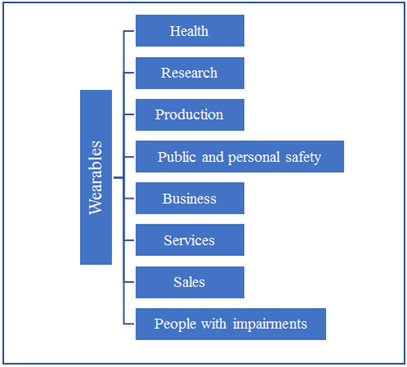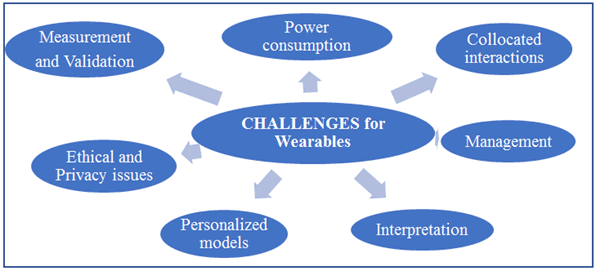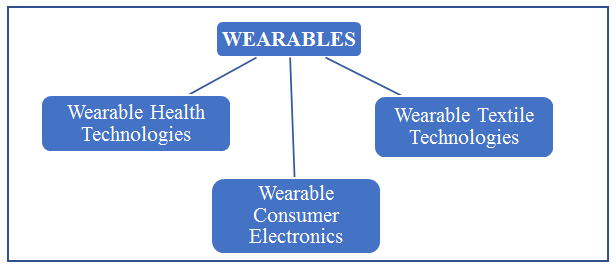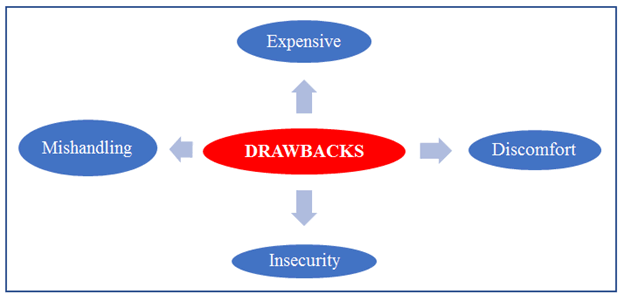Review Article - (2022) Volume 7, Issue 1
Wearable Gadgets in Healthcare Management: A Systematic Review
Sasidhar Rajana1* and
Kusuma Latha Beera2
1Department of Pharmaceutics, Vignan institute of Pharmceutical sciences, India
2GITAM Institute of Pharmacy, India
*Correspondence:
Sasidhar Rajana, Department of Pharmaceutics, Vignan institute of Pharmceutical sciences,
India,
Email:
Received: 03-Jan-2022, Manuscript No. IPJHCC-22-12693;
Editor assigned: 05-Jan-2022, Pre QC No. IPJHCC-22-12693 (PQ);
Reviewed: 19-Jan-2022, QC No. IPJHCC -22-12693;
Revised: 24-Jan-2022, Manuscript No. IPJHCC -22-12693 (R);
Published:
31-Jan-2022, DOI: 10.35248/ipjhcc - 7.1.7004
Abstract
With the technology improvements globally, there are vast improvements in the healthcare systems though. The
present review article discusses about the role of wearable gadgets, the characteristics, functions, types etc. Also,
a brief note literature on the wearable gadgets is also listed and different types of application were also discussed.
This review gives information on the wearable gadgets and how this has an impact on the healthcare management
instead of going and getting tested in the diagnostic centre daily which eats the time of us in this busy life-style.
Keywords
Healthcare management; Wearable gadgets; Life-style; Diagnostic tests; Technology
Introduction
Since the civilization journey, the technology has started developing
gradually. Technological innovations by the researchers,
manufacturers, practitioners and customers are capturing increased
attention of wearable gadgets or wearable technology
which is also known as wearables. These sensing, information
giving and communicating technologies fall under the category
of electronic devices that presents the information to users
by tracking a user’s lifestyle behaviours in order to provide
tools for better health management [1]. These are driving the
transformation of health care delivery towards a new path of
connected health care. Generally, these devices should be in
contact directly or loosely attached to a person i.e., one form
of wearables can be operated individually which functions like
a connector for device and gives information like a wrist worn
fitness tracker., other form of wearables capture the specific
actions and execute measuring like heart rate monitor worn
around chest. Though these are been existing since decades,
it has become lately popular and fashionable as well. This generation
has begun with smartphones, which is now a pervasive
technology [2]. Wearables are generally tagged with the concept
of internet, which transform future health care system.
These are promoting the health management by allowing a
consumer to self-care by tracking.
Generally, wearables can be worn through several ways and
forms wrist watches, wrist bands, rings, eye glasses, clothes,
badges, jewellery, and even shoes etc [3]. Though these devices
are ease to use, still the companies, institutions are working
to design these devices to provide more comfort, reliable etc.
To understand more about these wearables, the awareness is
required in order to differentiate these from other technological
devices and thereby its distinctive characteristics are to be
examined [4,5]. The main characteristic of wearables is, these
are partially or totally hand-free, as they enable the people to
access the data while performing their daily routine. According
to the literature, the following are the characteristics that
wearables should have [6-8].
Characteristics of Wearable Technologies
• The characteristics of wearable technologies must be;
• Convey information in effective manner
• Comfortable
• Hand-free functioning
• Multi-functional
• Portable
• Reliable
• Stable
• Socially accepted
• Useful
Functions of Wearable Technologies
The main functions of the wearable technologies are;
• Communication
• Data management
• Energy management
• Interface
• Integrated circuits
Communication, It is the transfer of the data through radio frequencies,
wireless systems like Bluetooth technology etc.
Energy management, is the most crucial function to run the
wearables with the help of batteries/charging etc.
Interface, is a helpline to for transferring the data between the
user and device.
Integrated circuits, help in receiving signals from the sensors
with processing units and wireless nodes on printed circuits of
the device and provide the data.
Therefore, these are the five main functions of the wearable
technologies.
The advances in wearable technologies and user acceptance
of available wearables pave the pathway towards seamless
physiological monitoring. These devices are designed and are
used for different purposes. These are designed and are in use
based on the usage and requirement. The device’s characteristics,
features vary with the use and design for using. These
are grouped, based on the usage, characteristics, features etc.
From the literature, it revealed that there are types of wearable
technologies. There will be numerous benefits and applications
of wearable technologies in the future. The usage would be
categorized based on the area of utilization (Figure 1).

Figure 1: The applications of wearable technologies based on area of utilization
Challenges for Wearables
Before using these wearables, we have some assumptions on
it, particularly on the way it works, its accuracy, reproducibility
and efficiency in monitoring and ease of maintenance etc.
These include, the concern related to lack of contextual as
well as quality of information, battery life, privacy and security,
proprietary algorithms and variables for annotating data streams. Maximum systems are developed for fitness market
rather than older adults and rehabilitation. These wearables
challenges in finding out its efficiency by extending its concern
on validation, standardization and interoperability.
Power consumption, is one of the biggest challenges because,
with no power, the wearable cannot work. Energy harvesting
or scavenging has been taken as an approach to enhance useful
feature of wearable sensor and are not outweighed by battery
cost, size and weight. Measurement and Validation are the critical
parameters to obtain accurate data from the wearables.
This part is still under study, being developing a common language
for measurement and evaluation of devices in order to
define, the device’s performance, safety and durability. Ethical
and Privacy issues, plays the crucial part while using because
these devices are exploiting the data from sensors such as accelerometers,
gyroscopes and pedometers, breath sensing,
heart-rate monitors and calorie trackers for potential as well
as commercial use, which raises a doubt that the how extent
the data ownership and ethical aspects of data from sensors
is used for interpretation and how extent the data is kept safe
and how much data has been leaked other than health record
like name, age, other personal information [9]
Management is the crucial thing in any device, in case of wearables,
storing the data which may be saved in cloud-based
server must be accessed. If large volume content is there, it
may take long hours, sometimes even days if not housed locally.
Interpretation is the major part as the stored data must
showcase exactly with precision. In case of the individuals who
use additional apps for recording exercises, some apps may not
match the locations and gives difficulty to determine. Some
cause confusion like whether the individual is inactive or not
wearing device. Personalized models are the Human centred
design, is an area where designing and developing persuasive,
seamless technologies that engage the users and provide positive
behaviour on a daily basis is challenging. For example, in
case of Parkinson’s disease patients, the wearable technology
can be helpful in monitoring fall detection, prediction in home
sitting, vibration feedback etc., to assist the aspects for better
understanding of intention and implement for better computational
framework. Collocated interactions are the technologies
that are focussed for providing more experience such as in
gaming platforms etc., (Figure 2).

Figure 2: Challenges for Wearables
Types of Wearable Technologies
1. Wearable health technologies
2. Wearable consumer electronics
3. Wearable textile technologies
Wearable health technologies: These are the health-based wearables, mostly carried out in health-care sector and moreover
these wearables are used about for the health applications.
Till date, the studies are going on to implement the design
and develop wearable systems for monitoring patient’s
health related issues, gathering real-world information. Thus,
doctors can easily monitor the heart-rate, blood-pressure, fever
and other indicators which work independently while patients
perform their daily routine activities. These health-related
wearables can be used for diagnosing and treating several
diseases. Literature states that, it can be used for e-health,
m-health, tele-health, tele-healthcare, tele-medicine, tele-care
and additionally in preventing chronic conditions like diabetes,
in clinical management of neurodegenerative conditions such
as Parkinson’s disease and by responding to emergency situations
like seizures in patients with epilepsy etc. Some vital application
of these wearables is, using this technology while undergoing
cardiac monitoring when a patient is cardiac arrested,
cardiovascular diseases, rehabilitation, analysing during stroke
etc.
Wearable consumer electronics: These wearables are the electronics
that are intended to use every day that provide communication,
entertainment and office productivity. Most of the
consumer wearables are Smart phones, TV, cameras, music
players, camcorders etc. Generally, these are worn to record
and capture daily activities. Today, we are seeing the companies
like Apple, Google, Microsoft, Nike, Samsung etc making
more investments on wearables. In this class, there are different
types of wearables like wrist watches, wrist bands, headbands,
rings etc, the most popular and promising products are
smart glasses and watches. Examples for electronic wearables
are; Google’s glass is one of the wearables, which is like a conventional
glass, composed of the computerized central processing
unit, integrated display screen, camera, microphone,
bone conduction transducer and wireless connectivity. As of now, Apple’s, Samsung’s, Xiaomi’s watches, counts the steps
while walking and additionally the heart pace whereas Samsung’s
Galaxy Gear 2, enables the user to read and send texts,
calls, and send instant notifications, monitor heart rate, exercises
etc.
Wearable textile technologies: The concept of using the wearables
has been recently adopted in textile industries. These
help to enable the wearable electro textiles for sensing the
body functions, monitoring and communicating facilities, date
transfer, control of environment and other applications. These
are bringing the changes in textile industries by providing the
unusual characteristics in nano-coatings and nano-fibres. The
most significant application of wearables in this field is clothes,
where colour changes on demand of the wearer. For example,
Philips company made a dress named “Bubelle” which changes
its colour based on the wearer’s emotions to attain popularity
and social acceptance of these textile wearables (Figure 3).

Figure 3: Types of wearables
List of Few Wearable Technologies since Decades
The following are the list of the wearable technologies that are
been there since decades (Table 1).
Table 1: List of Few Wearable Technologies since Decades
| Year |
Invention |
Description |
| 1268 |
Eyeglasses |
Roger Bacon has made first the lenses for optical purpose. On the other-hand in China and Europe reading glasses were already used. |
| 1665 |
Augmented senses |
Robert Hooke has inserted artificial organs to the natural which improve our other senses of hearing, smelling, tasting, and touching." |
| 1762 |
Pocket watch |
John Harrison has invented first practical marine chronometer to determine longitude at the time of travel through ship |
| 1907 |
First wrist watch |
Alberto Santos-Dumont, who was working as pilot has given idea to famous jeweler Louis Cartier to create a time piece so that he can keep his hands free for piloting. |
| 1960 |
Head mounted stereophonic television display |
Heiling has presented the idea of virtual reality simulator with handle bars, binocular display, vibrating seats, stereophonic speakers, cold air blower, and a device close to the nose that gives us effects of virtual reality |
| 1977 |
Wearable camera |
C.C. Collins of the Smith-Kettlewell Institute of Visual Sciences developed a five pound wearable with a head-mounted camera which was used by the blind persons. |
| 1994 |
Wrist computer with half QWERTY keyboard |
Edgar Matias and Mike Ruicci of the University of Toronto, has demonstrated this "wrist computer" which gives an alternative approach to the emerging HUD + chord keyboard wearable. The system was built from a modified HP 95LX palmtop computer and a Half-QWERTY one-handed keyboard. With the keyboard and display modules strapped to the operator's forearms, text could be entered by bringing the wrists together and typing. |
| 2005 |
Fossil Wrist PDA |
Wrist PDA which was running on palm OS was available in the market |
| 2010 |
Sony Smart Watch |
Sony has launched Android compatible wrist watch |
| 2013 |
iWatch |
Apple has launched iWatch â?? which is wearable computer can be wear on wrist and can work as full flagged mobile phone |
Applications of Wearable Technologies
Wearable computers can be used in many applications in which
they can be worn through user’s skin, hands, voice, eyes, arms
as well as motion or attention are actively engaged as the physical
environment. Various application areas are as follows:
• Augmented Reality
• Behavioral Modeling
• Health Care Monitoring Systems
• Service Management
• Smart phones
• Electronic Textiles
• Music Player through Eyeglasses
• Fashion Designing
• Military Services
Limitations or Drawbacks of Wearables
Limitations of the wearables are like mishandling, discomfort,
expensive and also insecurity (Figure 4).

Figure 4: Drawbacks of wearable technologies
Current Developments in Wearable Technologies
In the current trend, the techniques and applications of wearables
are focussing on rehabilitation. Under rehabilitation,
virtual reality (VR) systems, functional electrical simulation
(FES) and activity trackers are the wearable technologies being
applied. These facilitate the rehabilitation through exercise
programs and develop for specific health applications such as
patients with neurological conditions, musculoskeletal conditions,
pulmonary-impairment or with pain. Most systems are
used for monitoring and providing rapid user feedback on posture
and extremity movements but not designed for continuous
usage. If and so these are intended for use by internet
services, it widens the range of applications [10].
Future with Wearable Technologies
The electronic companies are now focussing on the wearable
technologies, while few are launching the initial versions of the
wearable products. This is becoming an early adaptable stage
for public and commercial use. In future, the powerful and
commonly held wearable product is Smart glass. As discussed
above, the smart glass is like a conventional glass but it has
the computerized central processing unit, integrated display
screen, camera, microphone, bone conduction transducer and
wireless connectivity. The price of it is too high right now but,
the price falls once these glasses reach maturity stage and social
acceptance of this device will accelerate.
Conclusion
For spreading the wearables, understanding the end-use must
go hand in hand with technology development. Many challenges
fall behind using wearables in routine as well as long term
use which are being addressed in clinical studies like power
consumption, durability, usability, comfort etc. Therefore, the
advances in technology which is being focussed on wearables
have a wide range of rehabilitation applications. The main objective
of this review is to give brief points on how wearable
technologies will become a milestone for the people using as
well as the companies manufacturing. In simple words, the future
will be easier, safer, healthier also quicker by using these
wearable technologies.
Acknowledgement
None
Conflict of Interest
The author has nothing to disclose and also state no conflict of
interest in the submission of this manuscript.
REFERENCES
- Binkley P F (2003) Predicting the potential of wearable technology. IEEE Eng in Medicine and Biology Magazine. 2(6):23-27.
[CrossRef] [ResearchGate] [GoogleScholar]
- Jaydip Sen (2012) Ubiquitous Computing: Applications, Challenges and Future Trends. International Journal of Engineering Research and Applications. 3(4): 610-616.
[CrossRef] [ResearchGate] [GoogleScholar]
- Haghi, M, Thurow K, Stoll R (2017) Wearable devices in medical internet of things: scientific research and commercially available devices. Healthc Inform Res. 23: 4â??15.
[CrossRef] [PubMed] [GoogleScholar]
- Chen KH, Chen PC, Liu KC (2015) Wearable sensor-based rehabilitation exercise assessment for knee osteoarthritis. Sensors. 15: 4193â??4211.
[CrossRef] [PubMed] [GoogleScholar]
- Hartmann H, Trew T and Bosch J (2011) The changing industry structure of software development for consumer electronics and its consequences for software architectures, J sys and softw. 85(11): 178-192.
[CrossRef] [SemanticScholar] [GoogleScholar]
- Liana DD, Raguse B, Gooding JJ, Chow E (2012) Recent advances in paper-based sensors. Sensors (Basel). 12(9):11505-11526.
[CrossRef] [PubMed] [GoogleScholar]
- Kim D, Shin G, Kang YJ, Kim W, Ha JS (2013) Fabrication of a stretchable solid-state micro-supercapacitor array. ACS Nano. 7(9):7975-7982.
[CrossRef] [ResearchGate] [GoogleScholar]
- Yonezawa Y, Miyamoto Y, Maki H, Ogawa H, Ninomiya I, et al. (2005) A new intelligent bed care system for hospital and home patients. Biomed Instrum Technol. 39(4):313-319.
[ResearchGate] [PubMed] [GoogleScholar]
- Chai Z, Zhang N, Sun P, Huang Y, Zhao C, Fan HJ, et al. (2019) Tailorable and wearable textile devices for solar energy harvesting and simultaneous storage. ACS Nano. 10(10):9201-9207.
[CrossRef] [ResearchGate] [GoogleScholar]
- Mohammed EA, Far BH, Naugler C (2014) Applications of the MapReduce programming framework to clinical big data analysis: current landscape and future trends. BioData Min. 7:22.
[CrossRef] [PubMed] [GoogleScholar]
Copyright: This is an open access article distributed under the terms of the Creative Commons Attribution License, which permits unrestricted use, distribution, and reproduction in any medium, provided the original work is properly cited.





